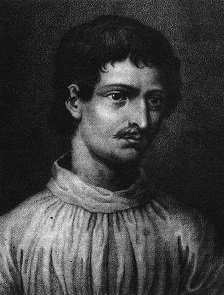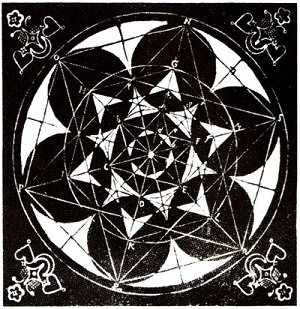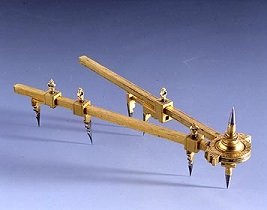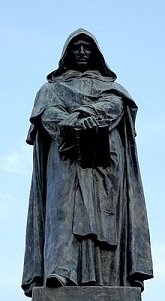Giordano Bruno, Hell-raising Heretic
Giordano Bruno was born in 1548 in a small house next to Mount Vesuvius, and it’s tempting to imagine that the fiery unpredictable mountain influenced his temperament. The house was near Cicala Castle in the town of Nola just outside Naples. His father was a mercenary named Giovanni, and he actually christened his son Filippo. Giordano was the name he would take later in life when he entered holy orders. From an early age it was clear that young Giordano was an incredibly intelligent young man. At the age of 14 he was sent to Naples to study, where he began to develop the systems of memorisation that he would use and refine throughout his life. Despite his obvious anti-establishment leanings his intelligence netted him a place in the only institution where a man from his background could study and learn – the church.
In 1565 the 17-year old Giordano entered the Dominican monastery of San Domenico Maggiore. From the beginning there was trouble. Giordano was usually the smartest person in the room, but the trouble was that he knew it and he thought the rules did not apply to him. His scholastic achievements were outstanding, and he was even taken to Rome to demonstrate his mnemonic system to Pope Pius V (who was originally a Dominican). It might have been this papal endorsement that allowed him to enter the priesthood in 1572 despite his reputation. Unfortunately for him Pope Pius died the same year, and Giordano’s disregard for the rules began to catch up with him. Reputedly the last straw was when he was caught with a copy of a book written by Erasmus. [1] He heard that a trial for heresy was in the works and so fled to Rome. There, so the story goes, he was framed for murder by enemies within the church. Whether this is true, or whether he was just afraid that the charge of heresy would follow him, he left Italy entirely in 1576.

Giordano first headed to Genoa and then on to Venice, where he wrote and published a book (now lost) in order to raise money. From Venice in 1579 he went to one of the most notorious Protestant cities in Europe – Geneva. At the time Geneva was synonymous with the new Calvinist movement, and scholars are divided as to whether Giordano converted to that faith when he arrived. [2] If he did, he proved as uncomfortable a Calvinist as he did a Catholic. He got into a dispute with Antoine de la Faye, a professor of philosophy at the University of Geneva. Antoine was friends with Theodore Beza, leader of the Calvinists (Antoine himself would eventually take on that role) and as such he could use his influence to make life unpleasant for Giordano. So the rambunctious priest moved on.
Giordano moved to France, spending time in Lyon and Toulouse before settling in Paris. In Paris he was able to win the support of powerful protectors, enough for him to begin producing the bulk of his writing. One of these patrons was the king, Henry III, who called him to court to demonstrate his “magical memory”. Giordano did this, though he explained to the king that it was not magic but merely mental training that gave him this power. The king was sufficiently impressed to back the young man, and one of his books on mnemonic systems (”The Shadows of Ideas”) is dedicated to the king. He also wrote a play called Il Candelaio – “the Candlemaker”. It’s a comedy set in Naples about an alchemist who seeks to turn base metal into gold, and an adulterer who seeks to win the true love of a prostitute, and how both suffer misadventure.

It may have been Giordano interest in magic that made him move to England in 1583. The story goes that he went in hopes of meeting John Dee, the notorious soothsayer, though whether he actually did is unknown. Officially he was a resident of the French Embassy. A brief stint as a guest lecturer at Oxford ended, as so many of his interactions did, in arguments. He had lectured on the Copernican view of the universe – heliocentric, and without the “cosmic spheres” that Plato had suggested. Though others had argued from evidence, his justification was purely philosophical – and enough to fill several books. However this also led to him being denounced by the lecturer George Abbot (later Archbishop of Canterbury) who declared that Giordano shared:
the opinion of Copernicus that the earth did go round, and the heavens did stand still; whereas in truth it was his own head which rather did run round, and his brains did not stand still.
Giordano’s response was to comment in one of his books that the lecturers at Oxford “knew more about beer than Greek”. He was also ridiculed for (apparently accidentally) giving a lecture that turned out to be a word-for-word repetition of a work by Marsilio Ficino. The perils, perhaps, of having too perfect a memory. Still, his time in England was when he wrote many of the works he is remembered for. Perhaps the most notable of these was The Expulsion of the Triumphant Beast, an allegorical work where the Greek gods have a meeting to replace all the constellations with more moral figures.
Everything has Divinity latent within itself. For she enfolds and imparts herself even unto the smallest beings, and from the smallest beings, according to their capacity. Without her presence nothing would have being, because she is the essence of the existence of the first unto the last being.
– The Expulsion of the Triumphant Beast
In addition to standing with Copernicus against Plato’s cosmology, Giordano also rejected the Platonic view that the universe was dual in nature – matter and spirit, form and substance. Instead he believed that the universe was of one single nature. This rejection of the concept of a “soul” would eventually be counted among his heresies. There is a theory that during his time in London Giordano sold secrets from the French Embassy to the English, though there is little evidence for this. In any event, when the embassy was attacked by a mob in October of 1585 and the ambassador decided to return to Paris, Giordano went with him.

In Paris, it took little time for Giordano to alienate his friends. He got into a feud with a mathematician named Fabrizio Mordente (who he met while visiting Prague) over the mathematics of circles. Typically, this started with a work Giordano wrote praising Mordente. He couldn’t resist throwing in some snide comments about some of Mordente’s conclusions that he felt were unjustified, and the mathematician took offence. Giordano responded by writing a couple of satires (including one called “The Triumphant Idiot”) about Mordente. Unfortunately for him Mordente had some influential patrons, while Giordano was already on thin ice for having published works directly attacking Aristotle. In May of 1586 Giordano was forced to flee Paris.
Giordano soon showed that among his many talents was an unending capacity to burn bridges wherever he went. He spent the next few years in Germany, moving from city to city as he wore out his welcomes. In 1589 he was excommunicated by the Lutheran church. Ironically this was in response to his book 160 Articles, which argued for religious tolerance and coexistence. He stayed in Germany, and moved to Frankfurt. It was at the Frankfurt Book Fair in 1591 that he met Giovanni Mocenigo, a Venetian nobleman.
Mocenigo wished to learn the art of memory, and convinced Giordano to return to Italy. It would prove a fatal mistake. Giordano’s original plan was to take up a chair in mathematics at the university of Padua, but his application was rejected. [3] So he moved to Venice, where he spent two months as tutor to Mocenigo. However the noble proved a poor pupil, and Giordano a cantankerous tutor. After two months Giordano decided to leave Venice and return to Frankfurt. Feeling snubbed, the faithless Mocenigo had his servants grab Giordano and lock him in the attic. He told Giordano that he would only let him go if he revealed his “secrets” of memorisation [4] but Giordano refused. In retaliation Mocenigo denounced him to the Inquisition. In May of 1591, Giordano Bruno was arrested for heresy.

The original charges against Giordano were based on Mocenigo’s account, where he claimed that Giordano had denied the transubstantion of the bread in the Mass (a key tenet of Catholicism), and that Giordano had descried Jesus as “a wretch”. However at first it seemed like he might get away, as the witnesses Mocenigo pointed them to all failed to back him up and instead said that Giordano seemed to be “a good Christian”. As always though, Giordano proved to be his own worst enemy. First he admitted to the inquisitors that he had “harboured doubts” about the divinity of Jesus since his days as a novice, though he later recanted this. Worse, though, he got into theological (and physical) altercations with his cellmates, men with much less scruples than the men Mocenigo had tried to use as catspaws. Still, Venice might have been persuaded to let him go – if the papacy in Rome hadn’t heard of his arrest and sent an extradition request. The Venetians weren’t bound to send him – but it was an easy way out, and a good chance to score diplomatic points. In February 1593 Giordano Bruno was loaded onto a boat and sent to the Eternal City, to meet his fate.
Once Giordano arrived in Rome he was put into a cell on the south side of St Peter’s square and the long drawn out process of his trial began. The major turning point came after about six months, when a letter from one of his Venetian cellmates (a Friar Celestino) arrived. Celestino listed those things he had heard Giordano say that he thought was heretical. Among these was his statement that there were many worlds in the universe, not just one, and his belief that Moses had no divine revelation on Mount Sinai, but instead formulated the Ten Commandments himself. The authorities were able to have these statements corroborated by the other cellmates, and so Giordano’s fate was sealed.

It was Giordano’s prolific writings that helped to stay his sentencing. The board of inquisition decided that they needed to track down all of his books and essays, and these proved to be spread out so much across Europe that they took six years to track down. In the meantime, Giordano worked on (and doubled down on) his defence. In 1599 the newly minted Cardinal Robert Bellarmine was appointed to the board of inquisitors. He was a former professor of theology, and his academic rigour crystallised the case against Giordano. The charges revolved around Giordano’s beliefs and statements about:
- The nature of divinity and the divine nature of Jesus
- The existence of multiple worlds
- Magic and divination
- The nature of the soul, both human and animal
Giordano spoke defiantly in defence of these beliefs, and he and Cardinal Bellarmine had heated arguments. This culminated in Giordano yelling at the Cardinal “You lie through your throat!” In response, the Cardinal and the rest of the board considered torturing Giordano to force him to recant. If they did so, it wasn’t recorded and it didn’t work. Giordano had clearly decided that death was preferable to recanting, while the board had decided that his beliefs merited death. And so, towards the end of 1599, they brought him into the courtroom and pronounced a sentence of death upon him. Giordano responded:
You may be more afraid to bring that sentence against me than I am to accept it.

Giordano had enough connections across Europe that executing him was not a step the Vatican took lightly. It took the personal intervention of Pope Clement VIII to have the sentence carried out. On February 8th 1600 he was formally stripped of his priesthood and turned over to the civil authorities. Nine days later he was stripped naked and fitted with an iron gag that drove spikes through his jaw and into his tongue. It was said this was to mortify the mouth that had spoken his lies, but it was more likely to deny him the chance of a final act of defiance. Then he was led out into the Campo de Fiora, tied to a stake and burned alive.
Ten years later when Galileo Galilei was placed on trial for heresy, it may have been the memory of Bruno that led him to decide to recant. The later acceptance of Galileo’s theories also prompted a rethink of Giordano Bruno, and many began to think of him as a martyr to freethinking. The Vatican, of course, would have no truck with that. One member of the board that condemned him went on to become Pope Paul V, while Cardinal Bellarmine was made a saint in 1930. To this day, they insist that Giordano’s death was his own fault for refusing to recant, rather than theirs for killing him. [5]

But through the 18th and 19th century Giordano Bruno became a symbol to European liberals and freethinkers – the man who chose death rather than submission to the shackles of faith. And towards the end of the 19th century, that symbology became actualized. In 1870 the newly formed Kingdom of Italy conquered the Papal States and ended the Pope’s authority over Rome. As a direct rebuke to the Vatican, they placed a monument to Bruno in the Campo de Fiori where he had been executed. It still stands there to this day, his hooded gaze reminding the Cardinals and Popes that the days when they could execute those who disagreed with them have passed. The inscription at the base of the statue reads:
To Bruno
From the Age he Predicted
Here Where the Fire Burned.
Images via wikimedia except where noted.
[1] Erasmus of Rotterdam was a 15th century Catholic priest who was heavily involved in the Reformation and the establishment of Lutheranism.
[2] Unsurprisingly it is the Catholic scholars who most insist on his apostasy. Giordano himself later denied having converted.
[3] Ironically the successful applicant was Galileo Galilei.
[4] Which at this stage Giordano had written about a dozen books on.
[5] The disquieting conclusion to draw from that is that the Catholic church still considers burning unrepentant heretics a moral thing to do.
